Course Software & Tools
In this course, we will be utilizing a number of different software platforms and tools. Some of the tools are optional, but are highly recommended. Setting up some of these tools will be easy, but others will expose you to some of the more frustrating aspects of working with computers. The best representation of what I’m talking about is this xkcd comic, entitled Dependency.

Essentially, modern software is a bit of a house of cards, and it’s not uncommon to spend hours trying to get something to work, only to find out that you were missing a single character in a configuration file or have some conflicting dependency. The key thing to know is that this is not a reflection of your ability to work with computers, but rather a reflection of the state of modern software. In fact, an HCI professor wrote an excellent post about how this type of configuration errors can deter students (you can read a bit about that here https://www.kevinbrowne.ca/command-line-bullshittery-and-other-realities-of-computing/). There’s also this great free MIT resources called The Missing Semester of Your CS Education https://missing.csail.mit.edu/2020/course-shell/ and https://missing.csail.mit.edu/2020/command-line/ that covers some of what we will be doing here if you would like more background information.
The remainder of this page contains installation instructions for the tools/software/programming languages we will be using in this course, listed in order of complexity of installation. Most of the links are operating system agnostic, but if indicated, please follow the instructions for your computer type (Windows = any computer running windows, Mac = any apple computer). Most of the instructions involve clicking on links to download programs, though a few also require you to paste text into your computer.
You should do your best to get through the majority of the installation instructions before our next class, but if you get stuck, please reach out to the instructor via Slack (especially if you’ve been trying for more than ~20 minutes) and also know that we will have time in our Thursday class session to help troubleshoot any installation issues. Again, any issue you face is a feature of the difficulty of working with computers, not a reflection or indication of your ability to code.
Slack

Slack is a communication tool that we will use for this course. You can download the app for your computer or use the web version. You can also download the app for your phone. You will need to create an account and join the course channel is310-2024 on DH@UIUC team. The link to join Slack is available on Canvas and in the syllabus, and you can add yourself to our channel or ask the Instructors for assistance.
I realize that Slack is less popular than a platform like Discord, but it is a very popular platform for Digital Humanities. In fact, the primary DH Slack Team is a great place to ask questions and get help from other DHers. You can read more about it and how this field uses Slack in this writeup by Amanda Visconti https://literaturegeek.com/2016/07/06/digital-humanities-slack-community-design.
You are welcome to make any username you want, but please be sure to share who you are in the course channel so we can all get to know each other.
Hypothesis
For our collective annotations, we will be using the Hypothesis platform. You can sign up for Hypothesis here hypothes.is/signup and join our collective group at the link in our syllabus or via Canvas. You will need to install the Hypothesis Browser Extension for your preferred browser as well. You should follow the instructions available in this Quick Start Guide https://web.hypothes.is/help/quick-start-guide/.
You are welcome to make your username whatever you choose, but please share your username with the instructor. And please be sure to make your annotations in our hypothes.is group is310-2024 and that these annotations are public. For more about using Hypothesis groups, see this guide https://web.hypothes.is/help/annotating-with-groups/.
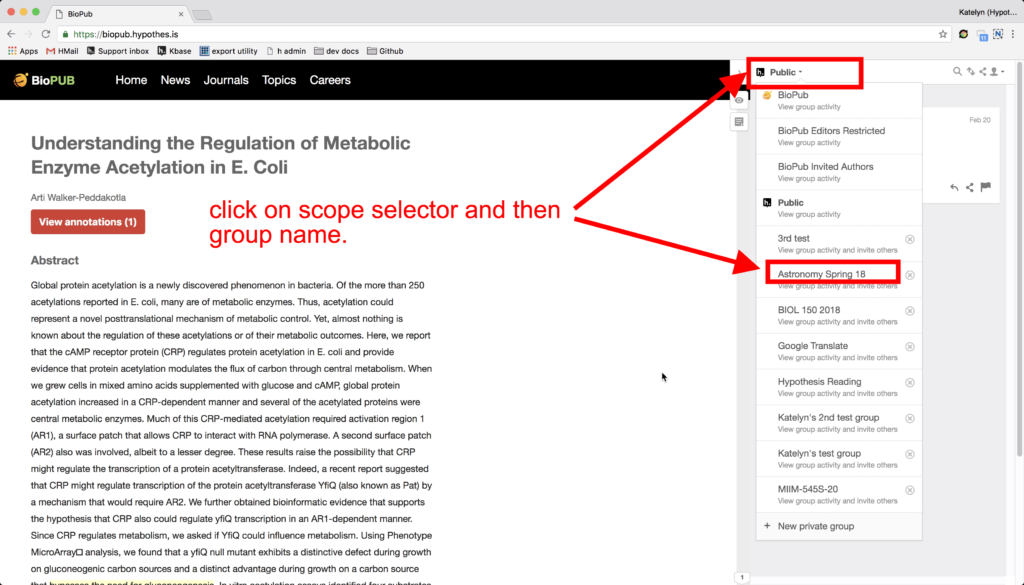
GitHub

If you do not already have a GitHub account, you will need to sign up for an account for this course. For those unfamiliar, GitHub https://github.com/ is a web-based platform that allows you to host and version code-related projects, while also working collaboratively. The best analogy is to imagine a blend of a data management and collaborative work platform like Google Drive with a social media platform like Twitter. It uses Git, a version control system, which is somewhat confusingly different from GitHub, to manage the history of a project.
GitHub is free to use (part of its popularity) and once you have an account you can store code and related materials (like datasets, for example) remotely, while also working collaboratively on these materials. The platform primarily consists of users, organizations (which users can join), and repositories (often called “repos” that are akin to folders or directories) for storing materials. In many ways, GitHub is similar to Google Drive, allowing users to both upload, organize, and keep versioned histories of their files. However, unlike Google Drive or other research management platforms, GitHub is also a platform for social coding, where users can publicly work on projects together, follow one another, comment on each other’s work, and view each other’s activity (somewhat like Twitter, Mastodon, Bluesky, etc…).
We will be delving into GitHub’s functionality in the next few weeks, but first you will need to sign up for an account. You can sign up for an account here https://github.com/join. GitHub provides additional documentation on signing up for an account. In terms of selecting a username, I would recommend choosing something that you plan to use professionally.
Once you have an account, you will also need to sign up for the GitHub Education Global Campus account https://education.github.com/benefits. You can find step-by-step instructions on how to sign up here https://docs.github.com/en/education/explore-the-benefits-of-teaching-and-learning-with-github-education/github-global-campus-for-students/apply-to-github-global-campus-as-a-student, but you will need to use your @illinois.edu email and show proof of your student status (either ID or academic record).
Getting approved might take a few days, but once you are approved, you will be able to not only create private repositories for free (we will get into what repositories are soon), but also use GitHub’s AI coding tool called Co-Pilot.
Both GitHub and Co-Pilot are owned by Microsoft, which acquired the platform in 2018 for 7.5 Billion dollars1, and the platform has become the de facto platform for hosting code, with the platform recently announcing that they had over 100 million of users.2
Considerations and Criticisms of GitHub

These numbers sound impressive, but should also be concerning. The consolidation of code and data on a single platform raises questions about the centralization of knowledge and the power of a single company to control the future of software development, if not all technology writ large.
While alternatives to GitHub exist (primarily GitLab or Bitbucket), it is hard to overstate how much in the last decade GitHub has become the platform for this type of work. Such a centralization is truly a double-edged sword. For example, GitHub has created what amounts to the largest code archive in the world through their GitHub Arctic Code Vault, an initiative to take a snapshot of all code hosted on their platform on February 2, 2020 and store it in the Svalbard Global Seed Vault. Such an initiative is impressive and was done in partnership with some academic institutions (the exact partners were the Long Now Foundation, the Internet Archive, the Software Heritage Foundation, Arctic World Archive, Microsoft Research, the Bodleian Library, and Stanford Libraries). But it also raises a number of ethical, archival, and political questions.
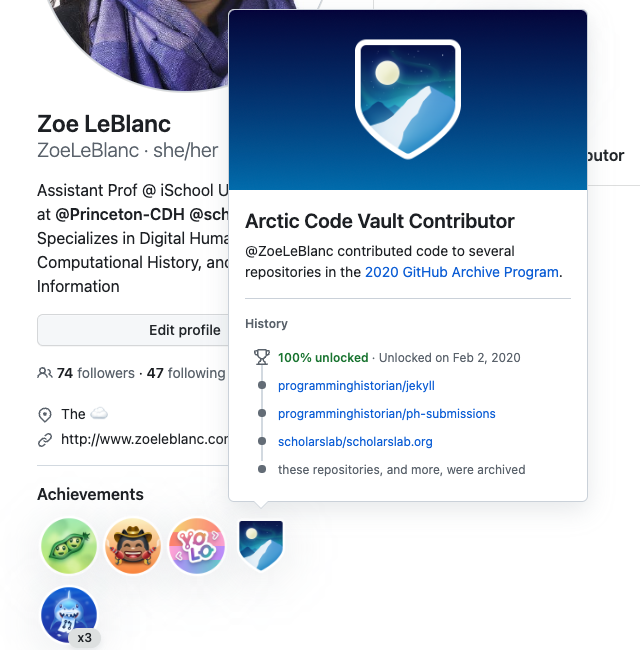
For example, this Arctic Code Vault has been criticized for its erasure of the indigenous Sami people who live on Svalbard and its performative approach to archives.3 GitHub also has contracts with U.S. Immigrations and Customs Enforcement (ICE) led to protests and boycotts from some sectors of the developer community.4 While we plan to use this platform, it’s important to do so with these issues in mind. For more on these criticisms, see:
- Fussell, Sidney. “The Schism at the Heart of the Open-Source Movement.” The Atlantic, January 3, 2020. https://www.theatlantic.com/technology/archive/2020/01/ice-contract-github-sparks-developer-protests/604339/.
- Mackenzie, Adrian. “48 Million Configurations and Counting: Platform Numbers and Their Capitalization.” Journal of Cultural Economy 11, no. 1 (January 2, 2018): 36–53. https://doi.org/10.1080/17530350.2017.1393443.
Why Use GitHub for Digital Humanities/Computing in the Humanities?
While primarily marketed towards software developers, GitHub is also incredibly popular for digital humanities. It is widely used for hosting data sets, text corpora, and other scholarly research assets. It provides a central place to publish, discover, and collaborate on such resources.
For instance, academic journals like the Programming Historian use GitHub for the entire publishing life cycle (you can explore for yourself https://github.com/programminghistorian/jekyll). You can get a sense of how popular GitHub is for digital humanities through searching for digital-humanities on the platform https://github.com/search?q=digital%20humanities&type=repositories or taking a look at the number of repositories on Github tagged as digital-humanities https://github.com/topics/digital-humanities.

Though this platform is very popular and useful for this course, we will do our best to use it critically and thoughtfully (a mindset we will hopefully bring to our various infrastructures and tools!).
AI Coding with GitHub Co-Pilot
As part of our course, we will be using GitHub’s new AI coding tool called Co-Pilot. Co-Pilot is a tool that uses machine learning to suggest code as you write. It is a bit like the auto-complete feature in Google Docs, but instead of just suggesting words, it suggests entire lines of code. You can read more about it here https://copilot.github.com/.
As a student on GitHub, you should be able to get free access to Co-Pilot. You can read more about how to get access here https://docs.github.com/en/github/copilot/getting-started-with-github-copilot.
If for whatever reason you cannot get access, please let the instructor know and we can try and find a solution. Other tools that may be of use include ChatGPT (the free 3.5 version) or gpt4all (which is a bit more complicated to set up).
VS Code
We will be using Visual Studio Code (VS Code) as our primary code editor for this course. You can download VS Code here https://code.visualstudio.com/ though I would highly recommend you download the . You should be able to use the link above to download VS Code for Windows, Mac, and Linux.Insiders Edition https://code.visualstudio.com/insiders/
Like GitHub and Co-Pilot, VS Code is also owned by Microsoft, which is why all three work relatively well together. VS Code is something called a Integrated Development Environment (IDE), which is a fancy way of saying it is a program for writing code. You can read more about IDEs here https://en.wikipedia.org/wiki/Integrated_development_environment. Other popular IDEs include Atom, Sublime Text, and PyCharm. While you are welcome to use any IDE you want, I will be using VS Code in this course and I’m not sure that Co-Pilot works with other IDEs, so would highly encourage you to at least test it out.

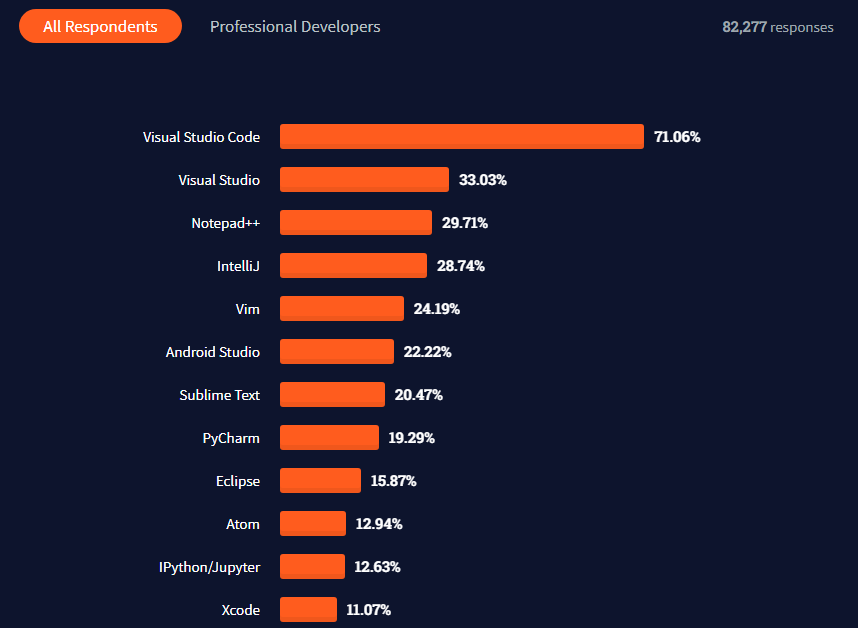
Another benefit of getting used to VS Code is that you can use it in the browser for any Github repository by changing .com to .dev. So for example if you took the link to our reposition, https://github.com/ZoeLeBlanc/is310-computing-humanities-2024 and switched it to https://github.dev/ZoeLeBlanc/is310-computing-humanities-2024, you would see the VS Code version of our repository in the browser.
Installation for Mac Users
For Macs, you will need to check if you have an Intel Chip or an Apple Silicon. You can check this by going to the Apple menu > About This Mac.

You can see in this example the Chip says Apple M2 Pro, which means this is an Apple Silicon. If you see Intel then you have an Intel Chip. Download the appropriate version for your computer through selecting the zip option and then opening and installing the program.
Installation for Windows Users
For Windows, you will need to check if you have a 64-bit or Arm64 operating system. You can check this by going to Settings > System > About and looking at the System type field.
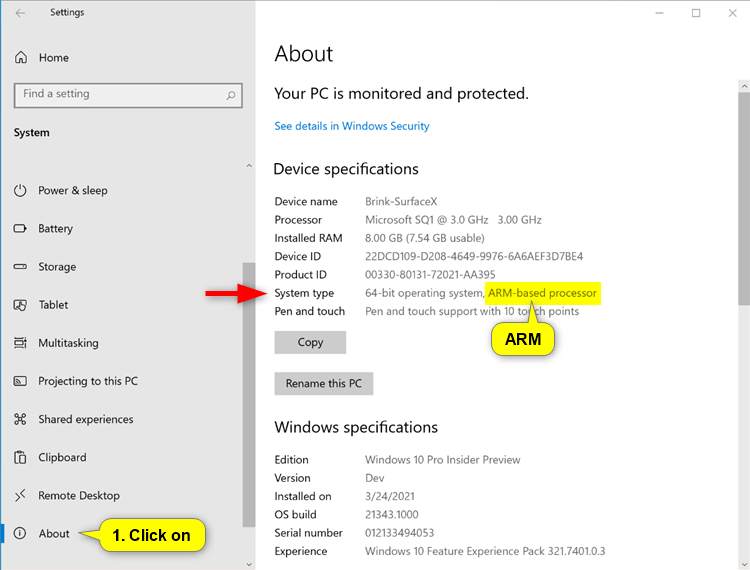
Once identified, you should select the User Installer option and then open and install the program.
VS Code Extensions
Once you have VS Code installed, you will need to install a few extensions. Extensions are a bit like apps for VS Code, and you can read more about them here https://code.visualstudio.com/docs/editor/extension-gallery. You can install extensions by clicking on the Extensions icon in the left sidebar of VS Code and then searching for your relevant extension. We will be installing various extensions over the course of the semester, but the first one you should install is the GitHub Copilot extension. You can find it by searching for GitHub Copilot in the Extensions Marketplace.
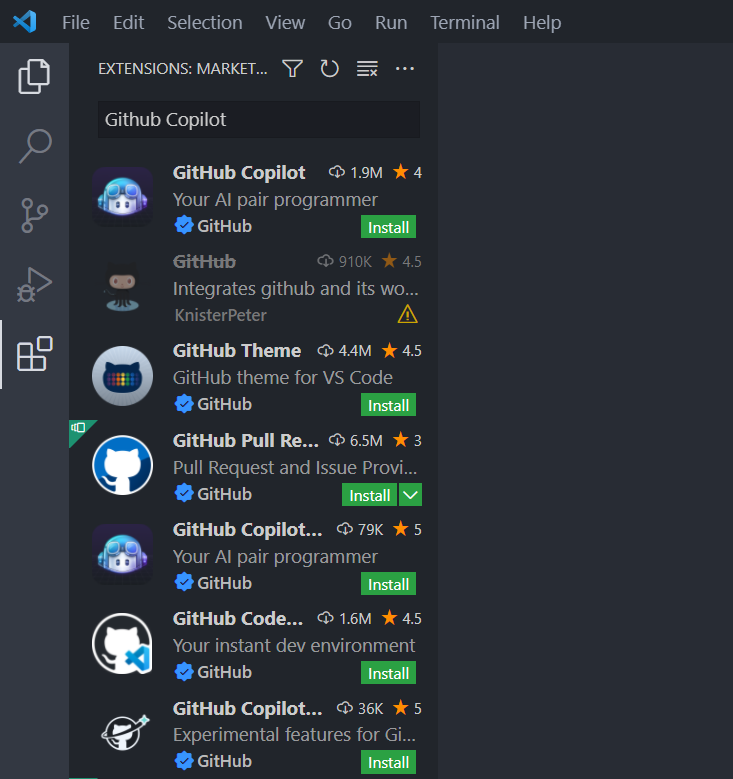
Once you click install, you will need to reload VS Code and then you should be able to use Co-Pilot. We will be learning how to use Co-Pilot with VS Code in the next few weeks, but you can read more about it here https://code.visualstudio.com/docs/editor/github-copilot.
Disabling GitHub Co-Pilot
While this class allows you to use AI tools, some of your other coding classes will not. So, if you need to disable Co-Pilot, all you need to do is click the Extensions icon in the left sidebar of VS Code, search for GitHub Copilot, and then click Disable.

Once it is disabled, you will need to reload VS Code. And then you can re-enable it by clicking Enable in the same location.

Python
What is Python?


You can read more about Python here https://en.wikipedia.org/wiki/Python_(programming_language) and here https://www.python.org/about/ (also in case you did not know, yes Python is named after the comedic Monty Python series). This course presumes you already have about a semester of experience with Python, if not more, but if you are new to Python, please let the Instructor know and also would highly recommend taking a look at the resources on The Programming Historian https://programminghistorian.org/en/lessons/ and looking at Melanie Walsh, Introduction to Cultural Analytics & Python, https://melaniewalsh.github.io/Intro-Cultural-Analytics/02-Python/00-Python.html.
Why Python?
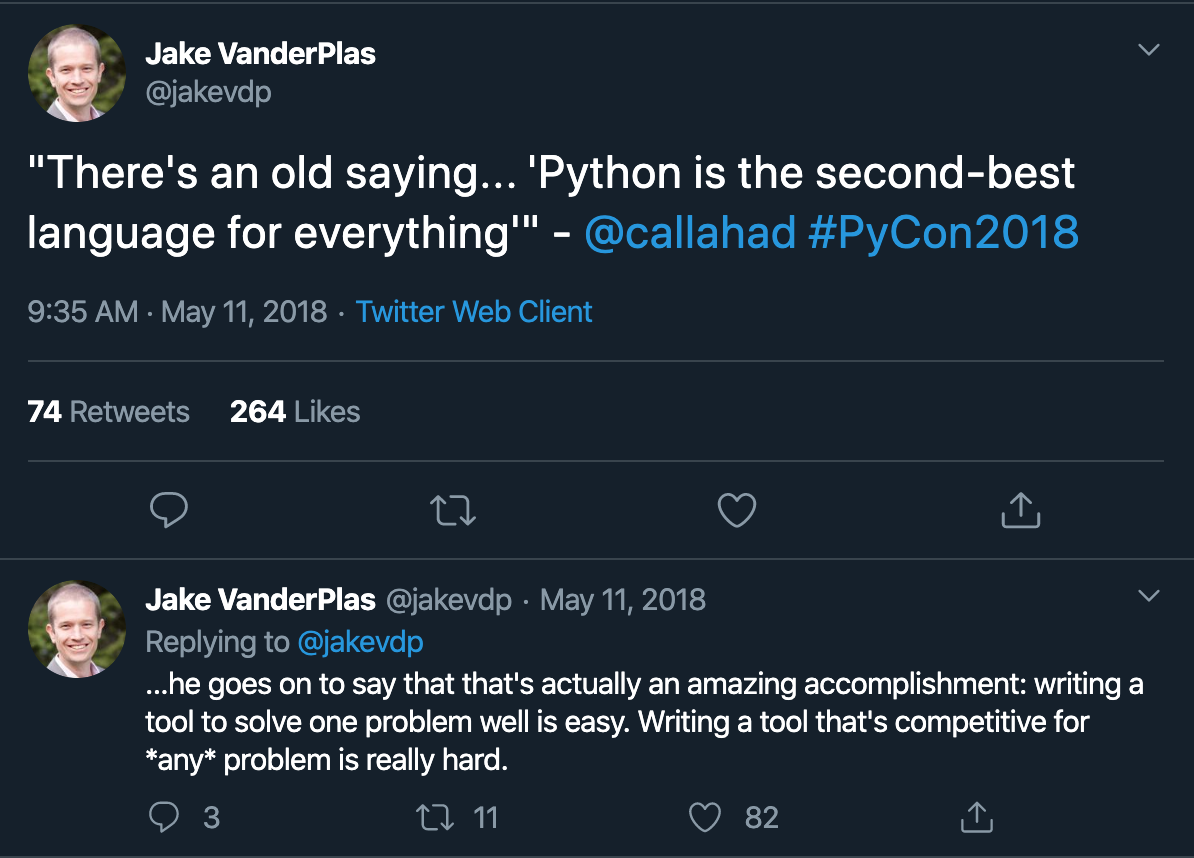 |
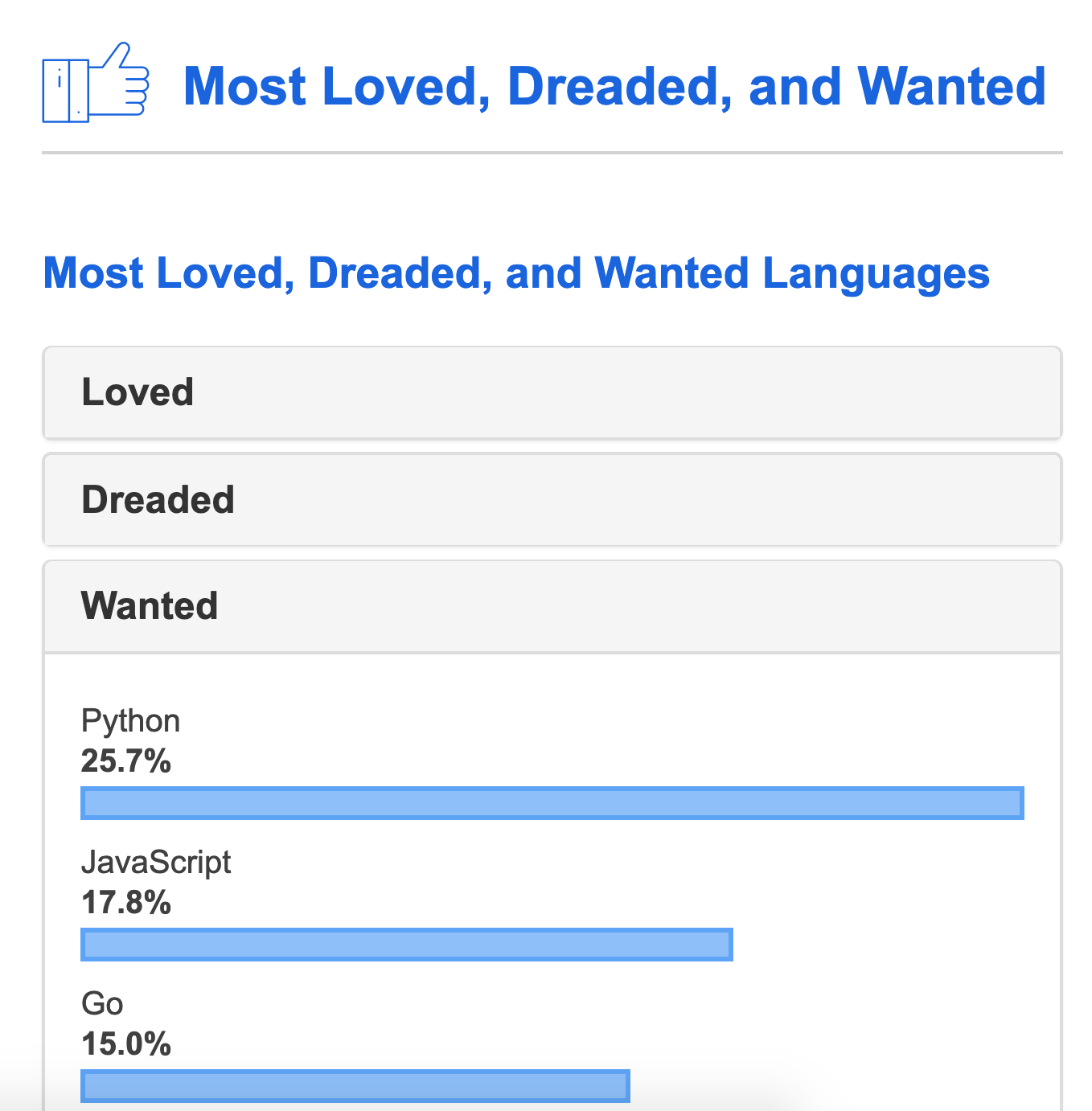 |
|---|---|
| Jake VanderPlas Tweet | Stack Overflow’s Annual Survey |
In this course, you’ll be writing code in a few different programming languages, but we’ll primarily be using Python. The choice of Python is for a few different reasons. First, Python is well suited to both web development and data analysis – two of the core activities of this course. Second, Python is increasingly becoming a standard in a number of industries and academic disciplines, though other languages like R are also popular. Third is that many of the programming concepts you will learn in Python can transfer relatively well to other programming languages. And finally, Python is a popular language for Digital Humanities research and is used by a number of different DH projects and platforms.
Installing Python
Installing Python and getting it correctly configured is increasingly a very challenging and time consuming task, but I believe it is worthwhile since you will ideally keep coding after this course ends. But I want to forewarn you that this process can be frustrating and time consuming, so please reach out to the instructor if you get stuck or if you are feeling unsure or nervous about this task. To give you a sense of what I mean, here is a comic from xkcd about the Python Environment.

Mac Installation
You may have previously used Anaconda for installing Python on your Mac. Anaconda has a number of benefits, but also a number of drawbacks once you start getting deeper into programming. For this course, we will be trying our best to install Python without Anaconda, but if you are having trouble, please let the instructor know and we can try and find a solution.
We’ll largely be following the instructions from https://realpython.com/installing-python/#how-to-install-python-on-macos.
The first step is to check if you have Python installed on your computer. You can do this by opening up VS Code and then opening up the terminal. You can do this by clicking on either the Terminal menu option and then selecting New Terminal, or selecting View and then selecing the Terminal optional. You should see a terminal window open up at the bottom of your VS Code window, and can find more detailed information on this here https://code.visualstudio.com/docs/terminal/basics.
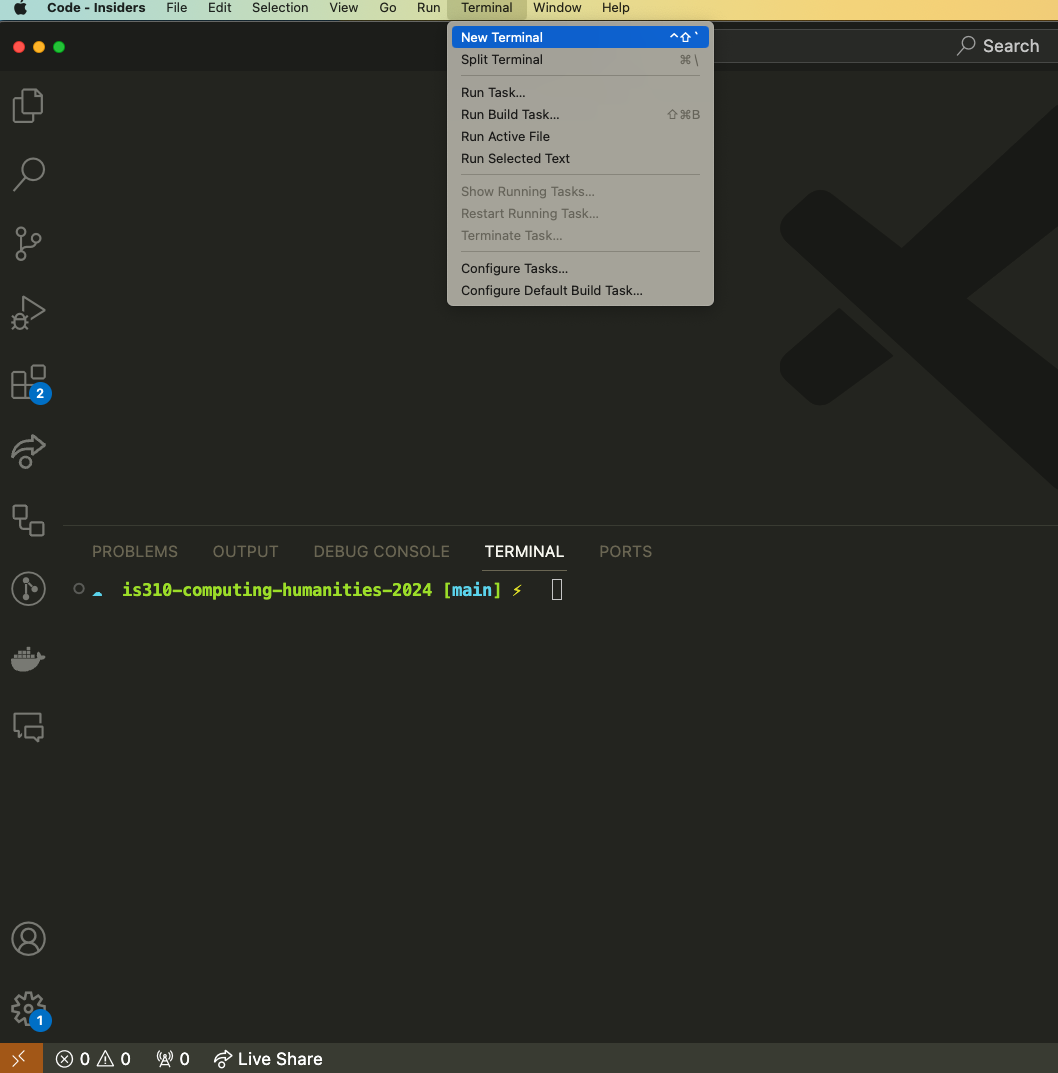
Once you have your terminal open, you can check if you have Python installed by typing the following command:
python --version
This should show you the version of Python you have installed, and it is likely going to be 2.7 since that ships with Mac. Unfortunately, that version is now officially retired and so will you might come across a library or two using it, you’ll end with a lot of errors if we don’t upgrade (also you can check the old countdown clock for the migration from Python 2 to 3 https://pythonclock.org/).
You should also double check that you have not already installed Python 3. You can do this by typing the following command:
python3 --version
If you have Python 3 installed, you should see something like this:
Python 3.9.7
While your version number might be different, you should see Python 3 in the output. If you do not see Python 3 in the output, then you will need to install Python 3.
There’s currently two ways to install Python on a Mac, using either the official installer or the Homebrew package manager. There’s pros and cons to each, and so if you think you might be using Python quite a bit going forward I would recommend the Homebrew approach, but if you are not sure, then I would recommend the official installer.
Homebrew Installation
Open a browser and navigate to http://brew.sh/. You should see a command for installing Homebrew near the top of the page under the tile “Install Homebrew.” It should look something like this:
/bin/bash -c "$(curl -fsSL https://raw.githubusercontent.com/Homebrew/install/HEAD/install.sh)"
Copy this command and paste it into the VS Code Terminal, and then press enter. You will be prompted to enter your computer password (i.e. the one you use to login into your Macbook). You will need to enter this password but you will not be able to see it as your typing. Once you have typed it, hit enter and then Homebrew will install.
You should also upgrade Homebrew by typing the following command into the terminal:
brew update && brew upgrade
This will take quite some time, so do not be concerned if it is taking an hour or more (more than that though there’s probably an issue and you should contact the instructor).
Once that’s complete, you may also need to install Xcode Command Line Tools, by typing into the terminal:
xcode-select --install
If you already have Xcode installed, you’ll see a message like this:
xcode-select: error: command line tools are already installed, use "Software Update" to install updates
Otherwise, you’ll see a message about installing the tools, and you’ll need to click Install to continue.
To ensure that Homebrew works with your computer, you will need to add Homebrew to your path. You can do this by typing the following command into your terminal:
echo 'export PATH="/opt/homebrew/bin:$PATH"' >> ~/.zshrc
And then:
source ~/.zshrc
We will discuss what this is doing a bit more below, but for now, just know that it is making it so your computer uses Homebrew with Python.
Then you will need to install Python 3 by typing the following command into your terminal:
brew install python3
You can check that you have Python 3 installed by typing the following command:
python3 --version
You should see something like this:
Python 3.9.7
While your version number might be different, you should see Python 3 in the output.
Official Installer
You can download the official installer here https://www.python.org/downloads/macos/. You should download the latest version of Python 3, which should be 3.12 and use the macOS 64-bit universal installer. Once downloaded, you should open the installer and follow the instructions. You can find more detailed instructions here https://realpython.com/installing-python/#how-to-install-from-the-official-installer.
Once installed, you can check that you have Python 3 installed by typing the following command in the VS Code terminal:
python3 --version
You should see something like this:
Python 3.9.7
While your version number might be different, you should see Python 3 in the output.
Windows Installation (Somewhat Optional)
If you have a previous version of Python installed on your Windows machine, you are welcome to use that rather than following the instructions below. I would highly recommend the setup described below if you have long term plans to use Python, but if you are not sure, then you can use your previous version of Python. However, even those this installation choice is optional, you must be able to run Python. So please reach out to the instructor if you are having trouble.
We’ll be following the instructions for using Python for web development on Windows https://docs.microsoft.com/en-us/windows/python/web-frameworks and https://learn.microsoft.com/en-us/windows/python/beginners.
Installing WSL
The first step is to install the Windows Subsystem for Linux following these steps https://docs.microsoft.com/en-us/windows/python/web-frameworks#install-windows-subsystem-for-linux.
In either PowerShell or Command Prompt, run the following command as an administrator:
wsl --install
You will then be prompted to restart your computer. Once restarted, you will need to open PowerShell or Command Prompt again as an administrator and run the following command:
wsl --set-default-version 2
According to the instructions:
This command will enable the required optional components, download the latest Linux kernel, set WSL 2 as your default, and install a Linux distribution for you (Ubuntu by default, see below to change this).
The first time you launch a newly installed Linux distribution, a console window will open and you’ll be asked to wait for files to de-compress and be stored on your machine. All future launches should take less than a second.
After this you’ll need to setup your WSL environment following these instructions https://docs.microsoft.com/en-us/windows/wsl/setup/environment.
Specifically you’ll need to set up your Linux username and password https://docs.microsoft.com/en-us/windows/wsl/setup/environment#set-up-your-linux-username-and-password.

Once setup, I would recommend first checking which version of WSL you are running and upgrading to WSL 2 if you are not already using it https://docs.microsoft.com/en-us/windows/wsl/install#check-which-version-of-wsl-you-are-running. And then I would recommend updating your packages for Ubuntu https://docs.microsoft.com/en-us/windows/wsl/setup/environment#update-and-upgrade-packages.
Customizing Windows Terminal and VS Code
Now that you have WSL installed, you can customize your Windows Terminal. I recommend using the https://docs.microsoft.com/en-us/windows/wsl/setup/environment#set-up-windows-terminal guide to customize your terminal.
You should also familiarize yourself with working with files in WSL https://docs.microsoft.com/en-us/windows/wsl/setup/environment#file-storage.
Now you can get VS Code working with WSL by following these installation instructions for working with the Remote WSL Extension https://docs.microsoft.com/en-us/windows/wsl/tutorials/wsl-vscode#install-vs-code-and-the-remote-wsl-extension.
According to the docs:
In order to install the Remote-WSL extension, you will need the 1.35 May release version or later of VS Code. We do not recommend using WSL in VS Code without the Remote-WSL extension as you will lose support for auto-complete, debugging, linting, etc. Fun fact: this WSL extension is installed in $HOME/.vscode/extensions (enter the command ls $HOME.vscode\extensions\ in PowerShell).
Now you can open Windows Terminal or PowerShell and type:
code .
And that should start your VS Code Server
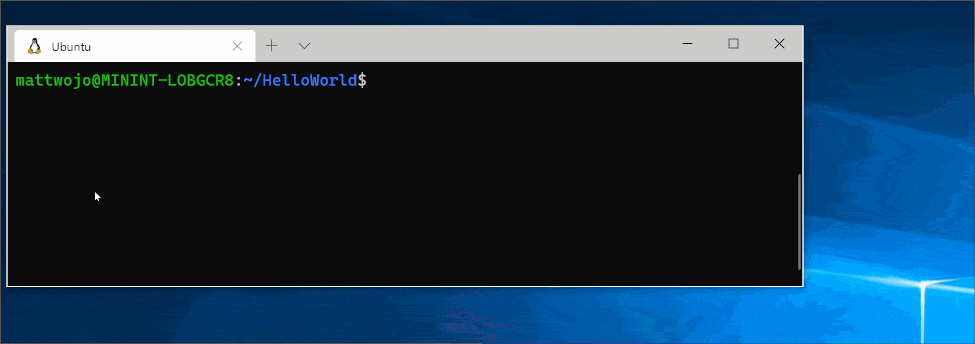
OR you can open VS Code and follow these instructions:
You can also access more VS Code Remote options by using the shortcut: CTRL+SHIFT+P in VS Code to bring up the command palette. If you then type Remote-WSL you will see a list of the VS Code Remote options available, allowing you to reopen the folder in a remote session, specify which distribution you want to open in, and more.

Break In Case of Emergency (Google Colab or Anaconda)
If, after consulting with the Instructor, you still cannot get Python installed, you do have installing Python via Anaconda or using Google Colab for this course.
Anaconda is a free and open-source distribution of the Python and R programming languages for scientific computing, that aims to simplify package management and deployment. You can read more about it here https://en.wikipedia.org/wiki/Anaconda_(Python_distribution). You can download Anaconda here https://www.anaconda.com/products/individual. You should be able to use the link above to download Anaconda for Windows, Mac, and Linux.
Google Colab is a free cloud service that allows you to write and execute Python in your browser. You can read more about it here https://colab.research.google.com/notebooks/intro.ipynb. You will need a Google account to use Colab, but you can use your @illinois.edu email.
I would prefer that we only use these options in the most extreme circumstances, but wanted to share that it is available and an option.
Terminals and Oh-My-Zsh (Optional)
Currently in VS Code, when you open a Terminal, you’ll see somewhat gnarly looking text like this:
zoe@ZoeLeBlanc MINGW64 ~/Documents/GitHub/is310-computing-humanities-2024 (main)
This is because VS Code is using the default terminal, whether for Mac or Windows.
We will discuss more in-depth what terminals are in our Command Line session, but for now, you should know that a terminal is a bit like an app for working with files, but instead of clicking on icons, you write commands. You can read more about terminals here https://en.wikipedia.org/wiki/Command-line_interface.
Installing a separate terminal is completely optional since VS Code has built-in functionality, but in case you would like to try it out, I recommend iTerm2 https://iterm2.com/ for Mac and the Windows Terminal https://www.microsoft.com/en-us/p/windows-terminal/9n0dx20hk701 for Windows (for more info about Windows Terminal see this blog post). You should be able to use both these links to download the appropriate version for your operating system, but please let the instructor know if you are having problems.
Once you have installed your terminal, you can customize it to be a little more human readable through using Oh-My-Zsh https://ohmyz.sh/. This step is again optional, but I find having a nicer and more readable terminal is helpful for working with code.
Windows Installation
Zsh is a unix shell and should be already installed on your WSL system. If not though you can install with the following:
sudo apt install zsh
Then you install oh-my-zsh with the following:
sh -c "$(curl -fsSL https://raw.github.com/ohmyzsh/ohmyzsh/master/tools/install.sh)"
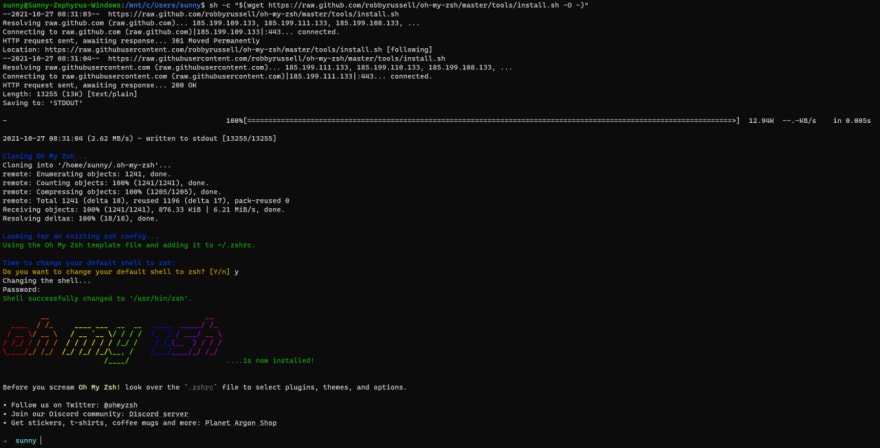
You can find more in depth instructions here https://dev.to/contactsunny/installing-zsh-and-oh-my-zsh-on-windows-11-with-wsl2-1p5i
Mac Installation
Zsh is a unix shell and should be already installed on your Mac.
Install oh-my-zsh with the following:
sh -c "$(curl -fsSL https://raw.github.com/ohmyzsh/ohmyzsh/master/tools/install.sh)"

You can find more in depth instructions here https://dev.to/hannahgooding/how-i-customise-my-terminal-with-oh-my-zsh-macos-427i
PowerShell Alternative
If you decided not to install WSL and our instead using PowerShell, rather than using oh-my-zsh which only works on unix/linux operating systems, you can instead install oh-my-posh, following these instructions https://ohmyposh.dev/docs/installation/windows. Again this step is optional but as you can see in the image below, these types of configurations do help make your terminal more human readable.
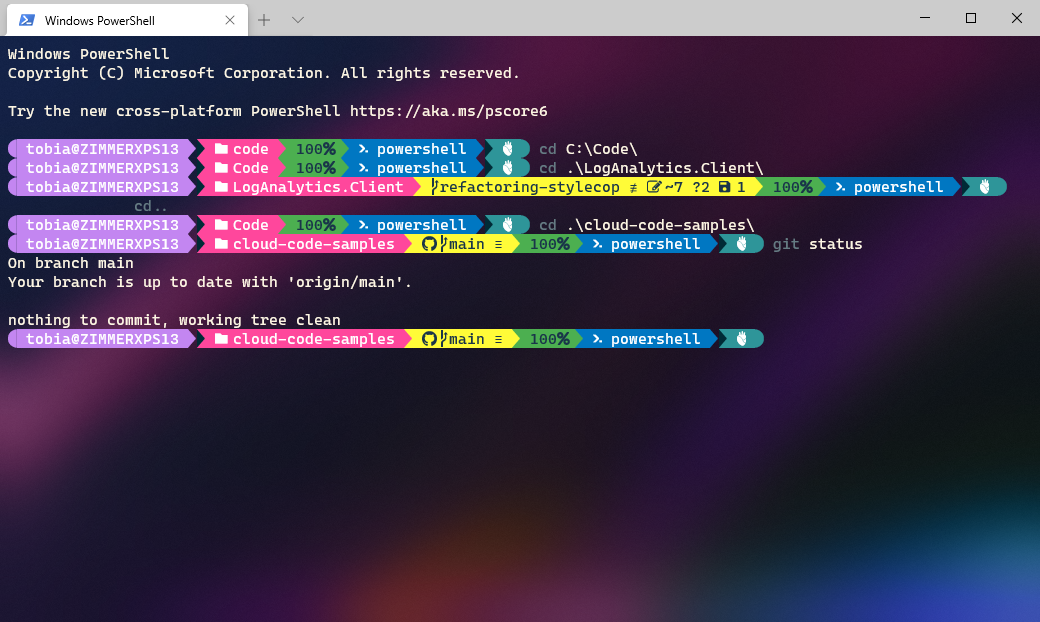
Git
What is Git?
![]()
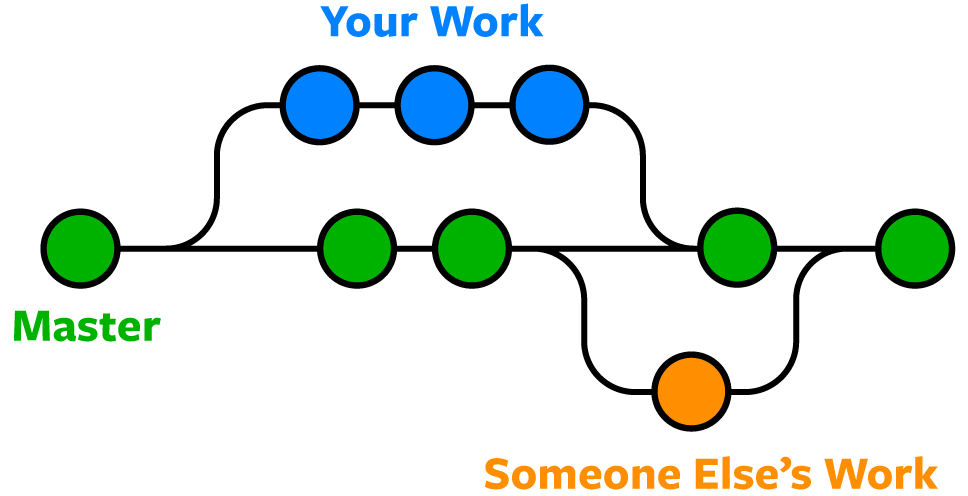
You can read more about Git here https://en.wikipedia.org/wiki/Git and here https://git-scm.com/about. Git is a version control system that allows you to track changes to files over time that was first created by Linus Torvals in 2005. It is a bit like Google Drive, but instead of just tracking changes to files, it also allows you to track changes to folders and directories. Somewhat confusingly, git is not the same as GitHub, though the two often are used together. We will be delving into these differences and how to use them later this week.
Mac Installation
Git should already be installed on your Mac, but you can check by opening up the VS Code terminal and typing:
git --version
If you do not have git installed, this will prompt you to install it. You can also install it by following these instructions https://git-scm.com/book/en/v2/Getting-Started-Installing-Git.
Windows Installation
Open the VS Code terminal and make sure that the WSL is selected as your terminal. You can do this by clicking on the Terminal menu option and then selecting Select Default Profile. You should see a list of options, and you should select Ubuntu or Ubuntu-20.04 (or whatever version of Ubuntu you have installed).
Now you first need to update the package list with the following command:
sudo apt update
Then you can install git with the following command:
sudo apt install git
You can check that git is installed by typing:
git --version
Git Configuration
Once you have git installed, you will need to configure it. You can do this by opening up the VS Code terminal and typing:
git config --global user.name "Your Name"
git config --global user.email "your.email@example.com"
Be sure to get both of these exactly right, as they are used to connect your GitHub account and git activity.
You can also check your git configuration by typing:
git config --list
CONGRATS YOU’VE SETUP YOUR COMPUTER 🎉
-
For more about this acquistion see Warren, Tom. “Microsoft Confirms It Will Acquire GitHub for $7.5 Billion.” The Verge, June 4, 2018. https://www.theverge.com/2018/6/4/17422788/microsoft-github-acquisition-official-deal. ↩
-
Dohmke, Thomas. “100 Million Developers and Counting.” The GitHub Blog (blog), January 25, 2023. https://github.blog/2023-01-25-100-million-developers-and-counting/. ↩
-
David., “Seeds Or Code?,” accessed April 5, 2023, https://blog.dshr.org/2019/11/seeds-or-code.html. ↩
-
For more information on this topic, you can read “The Schism at the Heart of the Open-Source Movement” and Dear GitHub. ↩